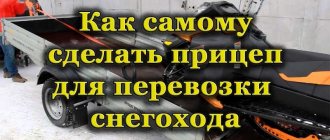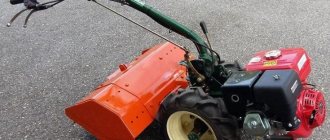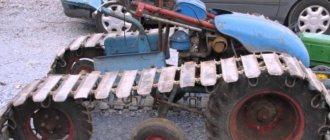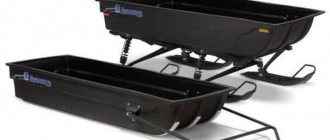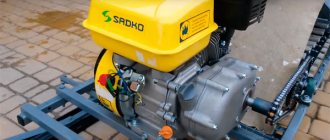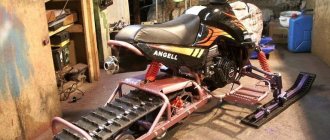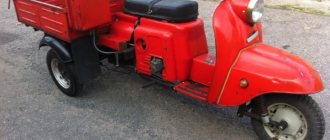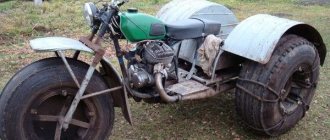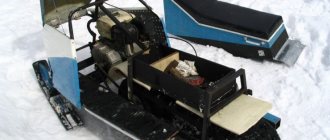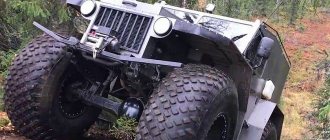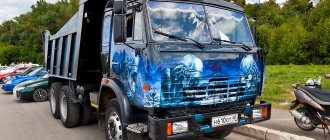- April 18, 2021
- Equipment
- Marina
A homemade motorized towing vehicle, a motorized dog, a homemade snowmobile, auto sleds - vehicles made for movement in the snow for those who love winter fishing, hunting or just winter fun. Replaces a team of dogs - pulls a loaded sleigh or even several. Lightweight, collapsible, easily transported in the back of an SUV or in the back of a car, economical in fuel consumption, works in low temperatures, and you don’t need to have a license or pay a tax to drive it. It works well not only in deep snow, but also on ice and on a cleared road.
Tools and materials
To carry out assembly work independently, you need a certain list of tools and materials.
You will need several tools.
- Welding machine. It is needed for joining metal, making it possible to obtain a reliable connection. To work with a welding unit, you need certain equipment, in particular, electrodes, as well as protective equipment.
- An angle grinder (grinder) is an indispensable tool when working with metals. It is necessary for dividing workpieces into separate parts. For the grinder, you need to select special attachments that will be required for working with certain materials.
- Electric drill - for making holes.
- A set of wrenches for working with fasteners.
From materials and units we will need:
- appropriate motor for certain operating conditions;
- profile and round pipe for constructing a skeleton (frame);
- wheels on the chassis.
How to make a cultivator with your own hands: simpler options
There is such a cultivator - “Nimble Baby”. Let's look at how you can make one at home. Take the tree axis. It will become connecting parts for other parts. A pipe 24 mm in diameter needs to be attached to this axis. It will serve as a handle, so in order not to bend too much, choose the length of the pipe to suit your own height.
Attach wheels with a diameter of less than 200 mm to the mentioned axle. the cultivator will rest on wheels, the height of the tool above the ground depends on the height of the wheels that we have adapted to it. By the way, the wheels must be cut from metal 2-3 mm thick. Once you have connected everything indicated, you will be able to work on the ground.
The word cultivator does not only mean motor units. You can also use hand tools at your own dacha. It is much better than a standard hoe and is even easier to make at home than a motor cultivator. Have you heard about the Tornado cultivator? It looks like a defective pitchfork.
Homemade cultivator "Tornado"
Tornados are easy to use thanks to the lever that the operator grabs when turning the cultivator into the ground. For the lever we need a pipe, which we need to attach to the handle. The pipe should be 50 cm in length. You can use electrical tape for fastening. As a pipe, you can use a nozzle on the handle, which is usually equipped with shovels. Such a lever will protrude 25 cm on both sides of the handle.
You can make a Tornado cultivator from spring steel. We take a plate half a meter long, 1-1.5 mm thick and 2 mm wide. Bend the steel and make a loop out of it, which you put on the handle. Watch the height of the cutting. It is important to maintain the diameter of the acquired loop - it should not be more than 20 cm in diameter in order to freely fit into the aisles.
There is another version of the cultivator - a rotary disk. We just warn you that you will need to apply a lot of physical strength to make the necessary convex disks. put ordinary iron discs and hit them with a hammer. They should become cup-shaped during the process.
We put the main part of the mechanism - specifically the disks - on a bushing, which we attach to the axle. We attach both ends of the axle using cotter pins on a large bracket.
We make a hole in the large bracket where we insert a pipe with handles and a crossbar between them. We place the rod on a small bracket using a welding machine. It should be 24 mm in diameter and 25 cm in length. We later screw a 16-diameter rod into the rod.
What is a motorized towing vehicle - description and purpose
A motorized dog is understood to mean a mini snowmobile (mini-all-terrain vehicle) with an engine. This vehicle is a coupling of a caterpillar towing vehicle with a sleigh or drag sleigh.
The driver of the motorized dog sits in the sleigh, and any cargo is placed there. Some dog models have a special cargo area on the tractor. Engine power is usually from 6 liters. With. up to 13 l. s., speed is 30-40 km/h.
The motorized dog does not have a brake, which the driver must always remember.
- Motorized towing vehicles are popular among fishermen and hunters. They can also be used in agriculture and forestry for transporting small loads.
- Unlike wheeled vehicles, skis on a motorized dog sled allow you to move even on loose snow and winter off-road conditions, which makes the vehicle resemble a snowmobile.
- The only difference is the driver’s position: he sits outside the platform with the motor, which reduces the weight of the motorized dog and increases cross-country ability. Also advantages in comparison with a snowmobile are the simplicity of the design and lower price.
- You can use motorized dogs to move along the frozen surface of a body of water - a lake, a river. They are ideal for ice fishing enthusiasts and have been designed specifically for them.
- The machine can be easily transported in a car using a cover, unloaded on shore, and then used for its intended purpose. On a motorized dog it is possible to transport cargo over rough terrain, replete with descents and ascents.
- They use the equipment for traveling in summer, spring, and autumn along swampy meadows and forest paths.
Why is it worth making a motorized dog - reasons
Both purchased equipment and homemade equipment are unpretentious, compact, and do not require much space for transportation and storage.
But some hunters prefer to make motorized dogs themselves, using improvised means. The main reason is cost-effectiveness: a homemade version will cost an order of magnitude cheaper.
For no more than the cost of the simplest towing vehicle from China, you can also build a reliable, durable pusher towing vehicle.
Many models of motorized dogs, especially those made in China, have a lot of design flaws. For example, the caterpillar can often become clogged with snow, which is associated with mistakes by the developers. Other possible problems are the motorized dog rearing up, burying itself in too deep snow, throwing snow into the sled. All these troubles can be avoided if you build the vehicle yourself.
With a front-mounted motorized dog engine, which is almost always planned in home-made models, the operation of the machine will be much more efficient. Here are the obvious advantages:
- fuel savings and overall reduction in design costs;
- higher driving speed;
- the ability to make additional compartments for gear.
On caterpillar tracks
Track supports are used more often than others, simultaneously performing the function of propulsion. The reason is high efficiency and reliability. This design allows you to reach high speeds while maintaining stability and maneuverability. There are several options for how to make tracks for a snowmobile with your own hands:
- from a conveyor belt;
- from truck tires;
- from driving V-belts.
Plastic or PVC tubes no larger than an inch in diameter, sawn along the axis, must be bolted across the conveyor belt.
Even a child can handle such a lightweight device.
Old truck tires with winter tread can also be used as tracks if you cut off the sidewalls. They don’t need crossbars, but you will have to sweep the edges with fishing line in centimeter increments, otherwise the tire will quickly become frayed.
Drive belts, just like the conveyor belt, must be equipped with lugs. Several parallel belts, 2 or more, are connected to each other by transverse strong lugs, attaching them to the belts with rivets or with screws. The distance between adjacent hooks should be equal to the pitch of the drive sprocket.
Tracks made from conveyor belts or belts are often reinforced with a chain, which increases the reliability and durability of the propulsion unit.
These snowmobiles combine lightness with a reliable drive.
One of the varieties of tracked snowmobiles is a motorized dog, which was named after its resemblance to a sled dog. At the expense of maneuverability, the design was lightened, and the traction force also increased. But this is the most effective towing mechanism in the snow.
To change direction, you need to make significant efforts to shift the center of gravity of the motorized dog.
When driving, discomfort from headwinds is alleviated by installing motorcycle glass and mudguards for the feet. But it is impossible to completely protect yourself from the cold wind on such transport. For comfort, you need a completely enclosed cabin, which means the weight will increase and a more powerful engine will be required.
A snowmobile with a car engine is designed for long trips over long distances. With heat-insulating body material, the ride is comparable to the comfort of a passenger car.
And the easiest way to achieve comfort is to simply place a rear-wheel drive vehicle on wide supports such as skis, tracks or pneumatic wheel tubes, and also drive the standard wheels to the snowmobile propulsors and attach the front ski to the steering bipod.
During manufacturing, it would be useful to provide a replaceable scheme for replacing wheels with skis and back, if you use spare parts for the conversion.
Maybe it's better to buy a snowmobile?
Today, ready-made snowmobiles and motorized towing vehicles from various companies are available for sale. Their cost starts from 100,000 rubles. and higher. The price of snowmobiles from branded companies exceeds 1,500,000 rubles. Not everyone can buy one. Not only are they very expensive in themselves. A snowmobile requires a separate place in the garage; it has high fuel consumption and expensive maintenance. In order not to receive a fine, you must obtain an A1 category license, which is issued to drivers of self-propelled vehicles by Gostekhnadzor.
It is prohibited to drive a self-propelled vehicle without a license. You will also have to pay transport tax for a snowmobile.
Options for interesting homemade products from a walk-behind tractor
Having bought a walk-behind tractor, its happy owner solves most of the problems associated with cultivating the site. A rich set of attachments allows you not only to plow the soil efficiently, but also to cultivate it, harvest potatoes, clear snow and pump water.
You can always buy a trolley for a heavy walk-behind tractor, which will turn it into a mini-truck.
What should the owners of medium and small walk-behind tractors, which are not structurally suited for transporting goods and performing other “tractor” work, do?
One thing can be firmly said: you shouldn’t sit back and wait for a miracle. Anyone who understands the mechanics of cars can make many interesting cars out of a walk-behind tractor.
Selection and production of basic elements
The main components, basic components and controls of a motorized towing vehicle should be discussed in more detail.
Engine
The most important component of the equipment is the motor (power unit). As a rule, a single-cylinder carburetor engine is used to manufacture motorized towing vehicles. An equally important element is the caterpillar - suspension and propulsion. With the help of the caterpillar you can move on ice, snow cover, and soft ground in warm weather.
In most cases, motorized towing vehicles use motors from Honda, Yamaha (expensive) or Chinese brands (MTR, Lifan and others, affordable).
These motors vary significantly in cost, although their power is usually equivalent. Lifan engines equipped with a centrifugal clutch performed well.
Some craftsmen use engines from a walk-behind tractor (cultivator) and engines from chainsaws (motor saws) “Ural” and “Druzhba” to make motorized towing vehicles.
The Sh-58 motor from a moped, designed for manual gearbox shifting, is in demand. Scooter motors can be used equally. The main condition is that the units have good traction properties, a power of at least 6 horsepower. This is quite enough to transport one person and 30-50 kilograms of cargo on a motorized towing vehicle. To move 2 people and 150-200 kilograms of cargo, it is advisable to choose a motor with a power of more than 9 horsepower.
Support frame
The quality level of the frame must be high, since during movement it is subject to heavy loads, especially when moving off-road. This structure is constructed entirely on its own, welded from profile pipes with a rectangular cross-section. Basically, a pipe with a wall thickness of 3 mm is sufficient - thinner metal is not suitable, it can quickly deform.
The assembly of the homemade product is carried out according to the previously selected drawing (about the same as ours).
To make the frame, take 2 pipes measuring 20×20 millimeters, add two more with a cross-section of 20×40 millimeters, and form the frame.
2 corners of 40 millimeters each are welded into it, and a safety structure for the engine is welded on top, which will prevent it from being damaged when the equipment turns over. It also doesn’t hurt to “sew” a galvanized sheet to the frame using rivets to cover the track.
Suspension
Suspension (suspension system) is an important factor in the functioning of the chassis. The size and speed of movement will depend on the type of system chosen.
The structure of the suspension system comes in several varieties:
- combined;
- slimy;
- skating rink
The fastest is a slip suspension, since the gap during movement is clogged with a minimum amount of debris, snow and other foreign objects. As a result, the engine will function with minimal disruptions, without overloads and excessive heating, however, slides are used exclusively in winter: they require snow, which serves as cooling for the ski module.
For traveling at any time of the year, you should choose a modern roller-type suspension system, but not with rigid ones, but with spring roller supports.
Such a motorized towing vehicle will move more smoothly on frozen roads. The roller behaves worse on snow cover (when moving, it is advisable to avoid too loose, deep snow), but is ideal for moving in the summer months.
Combined types of suspension combine both the advantages and disadvantages of slides and rollers.
Transmission
The transmission (power train) is responsible for transmitting the rotation of the shaft to the drive sprocket (profiled wheel) of the track. The power transmission can be automatic gearbox, mechanical, CVT; some varieties, for example, are equipped with a reverse gearbox from “Ant” (for reverse gear). The advantage of an automatic power transmission is the large horizontal traction force, the disadvantage is the rapid operation of some elements and the need for regular maintenance.
- As a mechanical , you can use a box from a VAZ or another old car. Its advantages are ease of maintenance and no need for frequent adjustments, but the operation of such a power transmission is less comfortable.
- The CVT provides a smooth transmission of force from the engine to the track, which makes it possible to reduce the wear rate of elements and save on fuel. The disadvantage is the weak belt of the units, which needs to be changed regularly.
Caterpillar
Such devices are available for snowmobiles and special ones, designed specifically for motorized towing vehicles. They differ in width, height, length.
There are replacement snowmobile tracks on the market that can be practiced when creating motorized dogs.
Caterpillar tracks from “Buran” are in demand, but they are not characterized by increased cross-country ability; it will be possible to use a motorized towing vehicle on a Buranovskaya caterpillar exclusively on an ice-bound body of water, a well-rolled track.
You need to buy tracks that are not very narrow. A 50-centimeter product is suitable, as it makes the motorized towing vehicle stable, passable, and agile.
There are also “aggressive” caterpillar tracks on the market that provide increased cross-country ability, with a width of 550 millimeters and more, with a non-standard tread pattern. They have an increased lug height - it is 32 millimeters (the normal height is 21 millimeters).
Tracks for a motorized towing vehicle can also be made on your own. You can practice using a variety of materials: conveyor belts, motorcycle chains, water pipes, etc. The main thing is to make them of high quality, lightweight and reliable, so that there is a balanced grip of the tracks with the road surface.
Electrical equipment and control systems
To control a motorized dog, they use a steering wheel connected to the gearbox, gas, and clutch handle, which must be borrowed from any suitable old motor vehicle. As a rule, the basic configurations of motorized towing vehicles are equipped with a manual start, but at the client’s request it can be replaced with an electric starter or supplemented with a lighting coil.
All this can be built without much effort on your own, but the cost of manufacturing a motorized towing vehicle will increase.
You can easily do without an electric starter; in addition, manual starting is the most trouble-free in terms of failure. Nevertheless, it will definitely be difficult to drive a motorized towing vehicle without light at night; this system must be taken into account without fail. The vehicle should be equipped with a 7 A coil so that there are no difficulties with powering the headlights.
Assembly
First of all, preparatory work is necessary.
To avoid any difficulties with operating a motorized towing vehicle, the main thing is to immediately determine its key technical characteristics:
- load capacity;
- motor power;
- type of power transmission;
- engine starting system - electric or manual.
You also need to worry about the additional accessories of the motorized towing vehicle - winch, light, protective components, seats. After this, a complete drawing is developed, which will show all the subtleties. Then you can order a set of components for the motorized dog or select them yourself from those that are available from other motorized vehicles.
Now you can begin the assembly procedure.
- First of all, the frame (frame) of the motorized towing vehicle is made, which will make it possible to fix the engine, gearbox, and chassis. To do this, the selected profile pipes (in addition, a beam will do) are welded into a box in the form of a rectangle. Afterwards, the fastenings for all the main units of the motorized towing vehicle are welded. Once completed, you can install the motor.
- The chassis must be based on support bearings (popularly called “support”). Suitable bushings with a wall thickness of 5 millimeters are turned on a lathe.
- Using bushings, bearings are installed at the corners of the frame. Afterwards, the front and rear axles (axles) are created, which configure the shafts together with bushings and bearings. The rear axle of a motorized towing vehicle is made to be a drive axle by installing a profiled drive wheel on it and thoroughly welding it. It must be connected to the gearbox through a chain.
- The tracks of a motorized towing vehicle, as mentioned above, are made with your own hands from a conveyor belt more than 30 centimeters wide or purchased ready-made, only the latter will need to be divided and made wider by means of inserts. Tracks are made from wood, plastic pipes, or dismantled from an old snowmobile. At the gearbox, the engine is equipped with pulleys connected by a drive belt. The control components of the motorized towing vehicle are fixed to the steering wheel - the clutch handle is installed on the left side, the gas handle is installed on the right. The steering wheel is fixed to the frame by welding two pipes with a fork. The fork is placed on the rear axle and secured with welded metal washers.
- Upon completion of the work, additional motor dog devices are installed and the necessary equipment is installed. The design is equipped with a seating area, a compartment for cargo, and so on. The finished equipment is in no way inferior in terms of functional characteristics to factory products, will be made thoroughly and can be restored if it fails by the creator himself.
Assembly steps
We will divide the work of creating a homemade motorized dog with our own hands into 4 main stages. The first and last stages cannot be swapped. The 2nd and 3rd stages can be carried out in parallel.
1st stage. Planning
To begin with, it’s worth imagining what characteristics and appearance your motorcycle dog should have. Using ready-made diagrams and drawings, adjusting them to suit you, make a list of planned materials. This stage will help avoid mistakes and speed up the creation of the machine. The procedure and suggested materials may vary. The availability of tools and work space should be assessed. Buy what is missing. At the time of assembly, all materials and tools must be available and at hand. If you have an assistant, you will have your own motorized dog ready in 3-4 days.
2nd stage. Frame
- The base, the skeleton of the machine, is assembled. It holds all the elements and experiences stress and constant vibration. It should not bend, the welding seams should be reliable. This will determine how safe your self-assembled motorized dog is. The layout and drawings of your machine do not have to be exact. If all elements are present, the length, width of the frame, and welding points for fasteners can be adjusted on site.
- A do-it-yourself module for a motorized dog is made from pipes using welding. Rectangle made of profile 20 x 40 mm. The steering columns are made from the same profile, but with a larger wall thickness. It is worth considering that the motorized dog will experience constant vibrations, so we either initially make the module from stronger pipes, or we strengthen the structure later. For the steering wheel, a 20 x 20 mm profile pipe and a round pipe of approximately the same diameter are used. The place where the steering wheel is attached to the frame needs to be strengthened. This place is subject to constant pressure plus vibration. The rigidity of the frame should also be strengthened, for example, by welding crossbars from a 20 x 40 mm profile or another. It is also recommended to insert a smaller diameter pipe inside the pipe. We weld the plates securing the drive shaft to the frame. We make the engine mount from a 40 x 40 mm corner or another size. We cut 6-8 pieces and weld them into the front of the frame. We weld the suspension mounts of the motorized towing vehicle.
- We prepare the engine protective frame of the required shape and weld it to the frame. We weld the sections connecting the frame to the steering columns. Clean up the uneven edges.
- To avoid metal corrosion, we paint the welded frame. After the paint has completely dried, we cover it with a steel (aluminum) sheet using rivets.
- We drill holes for the bolts to secure the engine.
3rd stage. Chassis assembly
- We place the caterpillar, insert the drive shaft with mounted housing bearings inside it, then insert the balancer (rear shaft). We put the frame on top. We secure the frame with bolts and nuts. Use locknuts immediately. We install track tensioners. There are different track tensioners, you can choose the most suitable one based on your design.
- Between the shafts to support the caterpillar we place rollers (roller carts) or slides. Combined options are also used. Slimes can be supplied factory made of plastic. You can make wooden ones from durable wood. We secure them.
- We fix the mudguard, the tow bar, and tighten the track.
Look below for diagrams and drawings of the motorized dog. This technique is assembled with your own hands, but at the same time this option is very practical and reliable. The use of rollers in the chassis is very interesting here. This increases the production price, but makes your motorized dog equal to a snowmobile in terms of cross-country ability.
4th stage. Completing the build
- We secure the engine with four bolts.
- We install the sprockets, chain, chain tensioner (this could be the timing chain shoe).
- We install a steering wheel with a gas lever and a button to turn off the engine.
- We connect all the elements. We fasten the engine protection. Ready.
Pros and cons of wide tracks
A homemade motorized dog, made with your own hands, is more maneuverable and lighter with a narrower track (380 mm) than with 500 mm or more. This is important when you have to drive through the forest among trees and stumps, turn over or get out a car that has sunk (stuck) in the snow. It will be better if you can do it yourself without outside help.
- At high speeds, motorized dogs with wide tracks are more stable.
- On narrow tracks the speed is lower. Less cravings. The fact is that when using a gearbox, gear ratios can only be changed on sprockets. And here you have to sacrifice either speed or traction. If you use 12/40 chainrings, you can reach speeds of up to 20 km/h without loss of power.
- A more compact motorized dog is cheaper. If a motorized dog on 380 mm tracks can cost 25-30 thousand rubles, then on 500 mm it will cost no less than 60 thousand.
- More compact motorized dogs are cheaper to maintain. They are lighter - less fuel consumption.
- The cross-country ability even on loose snow is approximately the same for both options. But more compact motorized dogs are lighter: the track is lighter, even with the same length, and the engine weighs less (because it may be less powerful). This is important when you have to drive on frozen bodies of water - there is less danger of falling through the ice. If such a danger exists, then it is better to play it safe and purchase inflatable PVC cylinders (their volume is enough so that the towing vehicle and you do not fall under the water).
What is needed for production
It is absolutely possible and not so difficult to make a walk-behind tractor with your own hands. Schemes and drawings of a motorized dog are quite simple even for a novice master. You can assemble a car from scrap and not so expensive materials.
You will need:
- Frame. It can be welded from 20 x 40 mm profile pipes, angles and strips. You must first calculate the length, sketch out diagrams and drawings. A self-made motorized dog will be more passable and easier if it is shorter. This should be taken into account if you plan to drive through the forest or on ice.
- Caterpillars. These could be tractor tracks or a conveyor belt. You can make your own tracks from V-belts. To do this, we fasten the belts to the eyes or wheels. You can make tracks from chains: connect two identical chains in two circles, solder them - secure the links and reinforce them with steel plates on bolts. The width of the track is important, because a weak motor will have difficulty pulling wider tracks.
- Seat. For the seat, you can take foam rubber from old furniture, leatherette or leather from furniture or clothing.
- Motor. You can use an existing motor from equipment, or you can buy a specific domestic brand or foreign assembly. Chinese-made motors perform well. Motor power depends on desires and capabilities. Experts suggest taking engines from 6.5 liters. With. But on the forums, owners of motorized dogs admit that there is not enough power. 15 liter motor. With. more than enough to carry 2-3 people, overcome steep climbs, and reach speeds of up to 35 km/h (the optimal power is 9 hp). But there are reckless drivers who need a 20 hp engine. With.
- Galvanized, metal sheet or something else for cladding.
- Sprockets, bearings, chain, nuts, bolts, etc.
So, how do you make a motorized dog with your own hands with an engine?
Motorized towing vehicle - how they make it at the factory from A to Z
The designer drew the whole thing, measured every hole, every bolt, and attached everything. The assemblers are competent, professional, and assembled. The CMC shop welded the whole thing, painted it, did everything beautifully - appearance, design. They sold it to you and gave you a year of warranty, someone else gave it 2 years of warranty.
You drive, don’t worry. Something rustled, you dragged it to the dealer and said: Guys, fix it. Everything was done for you under warranty, and you can continue riding. And you no longer worry that you need to go to the garage, cut up this towing vehicle, and reassemble it, because something is wrong, something doesn’t work.
Anyone steps on their rake, even a professional welder. He cannot be a professional welder, he cannot be a mechanic, a person cannot absorb everything perfectly. Every person has mistakes, and he will make them in any profession.
Therefore, you can spend time, so to speak, when you assemble the towing vehicle yourself, there will certainly be savings. You will save some money, because the manufacturer has collected and needs to earn money, he needs to pay wages, rent, etc.
He appraised it, gave it to the dealer, and the dealer appraised it. Well, how much will you save? Dealer delta. You won’t be able to beat the factory price, because the plant has its own capacity, components, which it produces 70 percent of itself, rather than buying from someone else, so it’s easier for him. He already has it set up on a conveyor belt and goes in a chain.
He collects from 30 to a hundred a day, and people understand how to do it. The more you collect, the lower the cost. You take a kilogram of metal for 200 rubles, and if you take a ton, then the cost will already be 120 rubles. That is, the manufacturer will always be cheaper.
When you want to drink coffee, you don’t invent a coffee maker. You just go and buy it, because you know that it has been thought through to the smallest detail and that it will grind your coffee and make a really delicious cappuccino. If you start collecting it yourself, you will first get poisoned, then something will go wrong with you. That's true anyway. Having saved 10 thousand, you will spend a lot of nerves, time, money again. It's not worth it.
Features and types of motorized towing vehicles
A motorized dog is a type of tracked vehicle (with a crawler engine), a mechanical type vehicle that allows you to move independently and transport various loads in impassable areas. This unit is very popular among hunters and fishermen, especially among those who prefer this simple and small-sized equipment to modern ATVs.
Later, equipment appeared for different seasons with different purposes:
- Assistance in towing heavy loads;
- Movement in difficult places, through snowdrifts, wetlands, clay and mud;
- Help in agriculture and large production.
- Modern motorized dogs can have a load capacity of up to 350 kg.
The main components and controls of the structure:
- The engine (or power unit) is the most important component, the most expensive and structurally complex;
- Chassis;
- Swivel mechanism;
- Frame with fastening elements (holes);
- Power type unit frame;
- Sub-engine frame or Plate under the motor (responsible for reliable fixation of the engine);
- Steering wheel with built-in controls (including gearshift switch, gas and clutch handle);
- Ski module;
- Transmission (responsible for transferring useful torque from the engine shaft to the caterpillar of the motor towing vehicle itself).
The caterpillar attachment is a module where the driver’s seat and the walk-behind tractor installation area are located.
How to control a motorized dog:
- Sitting on a trailer;
- Standing on a sleigh.
You can start and stop a snowmobile tracked vehicle:
- Pressing the gas lever;
- Pressing the clutch.
It is recommended to purchase the chassis already assembled, but the remaining elements can be made independently. The fact is that the time frame for creating a unit can be greatly extended due to the complexity of the work, as well as the need for certain skills.
How to make a snowmobile from a chainsaw
The snowmobile is manufactured according to one of 2 schemes:
- single-track (2 skis in front, 1 track in back);
- two-track (1 ski in front, 2 tracks in back).
Any snowmobile device has the following design:
- Engine.
- Supply system.
- Oil injection system.
- Transmission.
- Chassis.
- Steering.
- Frame.
- Electrical equipment.
Before you begin making a homemade snowmobile from a chainsaw and its further assembly, you need to design drawings of all working components and the general appearance of the vehicle. It is better to draw each assembly unit separately and take out the dimensions.
During the development process, the brand of gasoline tool is taken into account.
The Druzhba chain saw has a simple design. The disadvantage is the low motor power (1 kW) with a large mass of the tool (12 kg).
Read also: DIY pipe cutter for plastic pipes
The Ural has a weight of 11.7 kg and an engine power of 3.68 kW.
- ability to work at low temperatures;
- high environmental friendliness.
When making a snowmobile from a chainsaw with your own hands, you can choose the Shtil brand. It is characterized by noiselessness during operation, a power of 1.5 kW, and has a nominal weight of only 3.9 kg.
Racks
The initial stage is the manufacture of the base of the frame structure from welded spars. For the middle part, corners 50x63 mm made of hardened steel are used, the front and rear are made of S2 steel with a flange at an angle of 90°. All elements must have holes of the same diameter for mounting with the track wheel and drive shaft. Brackets for road wheels are welded to the bottom of the frame.
The racks are made from 30x30 mm corners and connected by metal crossbars. The result should be a structure in the form of a small portal. A platform is required for the mounting location of the chain saw gearbox and the chain drive shaft. Sheet steel of the required size is selected, usually 2-3 mm thick, and welded to the center of the right side of the module and the portal.
At the back of the portal and at the same time in the middle of the module, a place is formed for the seat, which is subsequently made from boards and fabric or removed ready-made from old equipment, for example, a moped.
The front spar and the drive axle traverse are installed to the beam, which is a standard water pipe with a radius of 0.75 mm. Steering ski bushings are welded at both ends, and a stand for the engine subframe is welded in the center. The mounting points for the supports are reinforced with 2-mm metal gussets for strength and stability of the structure.
Caterpillar
The mechanism from the Buran unit is used as a caterpillar, the belt is shortened by 0.75-1 m. The gears of the gear drive are planted on the transverse shafts, then the web is laid. The caterpillar gear is made from a nylon sheet measuring 15 mm.
Drive shaft
To make the drive shaft, a metal pipe with a diameter of 14 mm is taken, and flanges are installed on top to fix the wheel teeth. At the ends of the mechanism, pin tips are pressed in and welded with space provided for bearings.
Engine
The snowmobile engine is the most important component that affects the operation of all self-propelled equipment. Therefore, experts recommend using a power plant from a Shtil chainsaw with an engine power of 1.5-3 kW. The motor is mounted on a stable support of the cross beam. The gearbox is rotated 180°, fixed on the platform, and the intermediate shaft of the 2-speed transmission is also mounted. The fuel tank is installed on top.
Asterisks
The drive sprocket with an internal key made of St20 is attached to the shaft with an M12 nut and a spring washer. For precise fixation, a thread of the required parameter is cut on the tip. It is taken into account that the 1st transmission stage corresponds to a large sprocket with the maximum gear ratio (on the Ural engine there are 38 teeth), the 2nd stage corresponds to a small drive sprocket with 10 teeth.
The chains are of a standard type, with a pitch of about 16 mm.
Brake system
If the snowmobile is designed to travel at low speeds of up to 30 km/h, then the braking system may not be provided. Vehicles are stopped by friction in the chassis and transmission systems.
Steering
Control - steering on support-steering skis. The support arms are rigidly connected to the steering shaft bipod. The steering wheel is two-handed, with a gas handle mounted on the right side.
Recommendations
Some tips on how to properly carry out maintenance to extend the life of your motorized towing vehicle, from professionals.
Track Maintenance
- In order for the caterpillar belt to work for a long time, you should adhere to a number of basic recommendations.
- Before you start operating (once a day), inspect the condition of the chassis: “stiff” rollers or loose bolts can become a source of caterpillar failure. After a break in operation, it is necessary to clean the track and elements of the suspension system from the ice crust.
- During winter or summer storage, do not allow the caterpillar belt to be exposed to direct rays of the sun and oils, fuel and other petroleum products for a long time.
- Over time, the track stretches and needs to be tightened.
- You can check the tension by measuring the sag of the track. A sag of 2 to 5 centimeters can be considered standard.
- It is worse to tighten the track too much than to loosen it too much, since this leads to stretching of the element and breakage of the driven and driven axle bearings.
- If the caterpillar has stopped making revolutions, this indicates a breakdown of the chassis. The main factor in its braking is the malfunction of the shaft supports or bogie rollers due to moisture penetration inside.
- You need to regularly inspect the condition of the chassis by rolling the motorized dog with your hands. It should also be easy to ride by hand with the chain and belt removed. Once every 12 months or every 40 hours of operation, maintenance of the undercarriage of motorized dogs should be carried out.
Motor Maintenance
The key rules are easy to learn. The first thing that needs to be monitored, in addition to refueling, is the oil level. To do this, unscrew the plug and look at the dipstick. Add oil to the required level. We change the oil every 5 tanks of fuel used.
A common problem is the air filter becoming clogged with tiny snow particles or the appearance of an ice crust. Signs: unstable operation, smoking, difficult to start. Dry the filter or install a new one.
Chain tension
The dog chain communicates rotational movements from the drive sprocket to the sprocket connected to the driven link; it should not be too tense, since the load on the bearings of the driven part of the CVT gearbox increases, and it should not be allowed to sag. The chain is tensioned by raising/lowering the right lobe of the hub, the driven part of the CVT gearbox. Over time, the chain can stretch and should be tightened.
Transmission Maintenance
Protect the CVT gearbox and its mating part from dirt, monitor the cleanliness and integrity of the aluminum discs, chain and drive belt of the CVT gearbox, wipe with a cloth after completing each drive, and prevent oil from getting on the belt and discs. Lubricate the shaft and cheeks as needed. Excessive amounts of lubricants can cause problems.
The uncovered chain drive requires constant maintenance and adjustment. Keep an eye on the chain tension.
After any trip, wash the chain with gasoline and lubricate or wipe the chain and profiled wheels. It is always advisable to take a backup circuit with you.
Keep an eye on the detachable connections, clean and let the motorized dog dry after any trip, store it horizontally in a dry, ventilated place, and your motorized towing vehicle will serve without breakdowns for many years.
